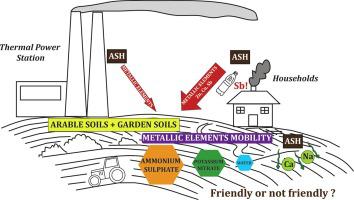Waste Management ( IF 7.1 ) Pub Date : 2021-06-14 , DOI: 10.1016/j.wasman.2021.05.035 Artur Pędziwiatr 1 , Anna Potysz 2 , Łukasz Uzarowicz 1

|
Wood and coal combustion generate wastes, which may negatively influence the environment. However, studies concerning coal combustion products serving as soil additives are currently in progress. Hence, this study was conducted to compare properties (mineralogy, metallic element content, and rare earth element content) of combustion wastes of different genesis (ash and soot after wood and coal combustion in households, ash from thermal power stations) and to assess possible risk posed to the soil environment when used as soil additive. This study demonstrated the diversity of chemical and mineralogical features of ashes of household genesis originating from thermal power stations. Ash from household stoves showed a higher concentration of metallic elements (i.e., Zn) compared to those originating from thermal power stations. Antimony (Sb) content in household ash can serve as an indicator of plastic (polyethylene) combustion, which is legally prohibited. Leaching tests using water and common mineral fertilizers showed that ammonium sulfate mobilizes metallic elements (Cu, Zn, Pb) more significantly than potassium nitrate or deionized water. The leaching of metallic elements from household stove’s ash certainly excludes the possibility of applying the ash as a soil additive even when the ash contains a source of beneficial elements for plants (i.e., Ca).
中文翻译:

火力发电站和家用炉灶的燃烧废物:性质、矿物和化学成分以及水和肥料对元素动员的比较
木材和煤炭燃烧会产生废物,这可能会对环境产生负面影响。然而,关于用作土壤添加剂的煤燃烧产物的研究目前正在进行中。因此,本研究旨在比较不同来源的燃烧废物(家庭木材和煤炭燃烧后的灰烬和烟灰、火力发电厂的灰烬)的性质(矿物学、金属元素含量和稀土元素含量),并评估可能的用作土壤添加剂时对土壤环境造成的风险。这项研究证明了源自火力发电站的家庭灰烬的化学和矿物学特征的多样性。与来自热电站的灰相比,来自家用炉灶的灰显示出更高浓度的金属元素(即锌)。家庭灰烬中的锑 (Sb) 含量可以作为塑料(聚乙烯)燃烧的指标,这是法律禁止的。使用水和普通矿物肥料的浸出试验表明,硫酸铵比硝酸钾或去离子水更能调动金属元素(Cu、Zn、Pb)。从家用炉灰中浸出的金属元素当然排除了将灰用作土壤添加剂的可能性,即使灰中含有对植物有益的元素(即钙)。









































 京公网安备 11010802027423号
京公网安备 11010802027423号